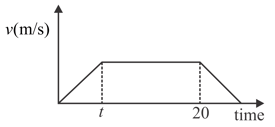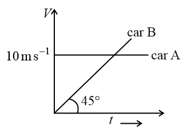A particle of unit mass undergoes one dimensional motion such that its velocity varies according to , where b and n are constants and is the position of the particle. The acceleration of the particle as the function of , is given by:

Important Questions on Kinematics
A particle moving along x-axis has acceleration f , at time t , given by , where and T are constants. The particle at has zero velocity. In the time interval between and the instant when , the change in particle’s velocity is
A ball of mass is thrown upward with a velocity . The air exerts an average resisting force . The velocity with which the ball returns to the thrower is
The velocity-time graph of a particle moving along a straight line is as shown in the diagram. The rate of acceleration and retardation is constant and is equal to . If the average velocity during the motion is then the maximum velocity of the particle is


The velocity displacement graph of a particle moving along a straight line is shown.

The most suitable acceleration-displacement graph will be
